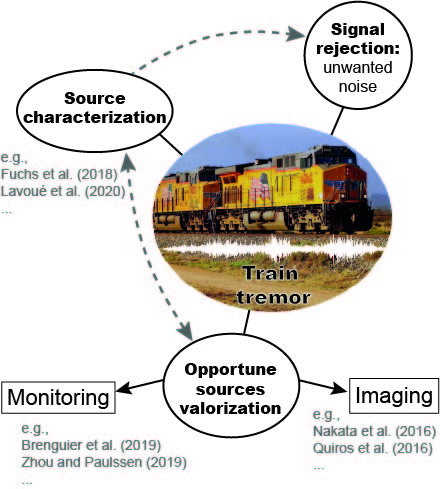Train traffic as a seismic noise source for imaging the shallow crust with seismic interferometry
Laura Pinzon-Rincon
Université Grenoble Alpes

- Date & Time
- Location
- Online-only seminar via Microsoft Teams
- Summary
Seismologists eagerly seek new and preferably low-cost ways to map and monitor the complex structure of the top few kilometers of the crust. Passive seismic imaging appears as a novel, low-cost, and environmentally-friendly approach for exploring the sub-surface. Usually, passive seismic interferometry relies on blind correlations within long time series of seismic noise or coda waves. Here, we propose a complementary approach: seismic interferometry using opportune sources, specifically moving sources that are not stationary in time. This new approach relies on an accurate understanding of the seismic source's mechanism, a careful signal time-window and station pairs selection, and seismic phase identification. For example, massive freight trains were only recently recognized as a persistent, powerful cultural (human activity-caused) seismic source. Thus, these train signals can be considered an opportune seismic source for passive seismic interferometry because they are readily available, detectable, repeatable, and generate high-frequency broadband energy. To illustrate this novel method's potential, we show a case study in a mineral exploration context at the Marathon site, Ontario, Canada, where we deployed a dense nodal array of 1020 sensors. We retrieve high-frequency energy using train signals only, and we use these arrivals to generate a 3D shear-wave velocity model. We discuss the pros and cons of the method compared to more standard approaches with the help of numerical modeling. We showed that by correlating train tremors, we retrieved high-frequency arrivals with higher quality than using the standard method while using fewer data. Far from being restrained to near-surface imaging, this new way of analyzing opportune seismic sources can be applied in various contexts and scales using natural or man-generated signals.
Closed captions are typically available a few days after the seminar. To turn them on, press the ‘CC’ button on the video player. For older seminars that don’t have closed captions, please email us, and we will do our best to accommodate your request.
 Jump to Navigation
Jump to Navigation